- Главная
- Разное
- Бизнес и предпринимательство
- Образование
- Развлечения
- Государство
- Спорт
- Графика
- Культурология
- Еда и кулинария
- Лингвистика
- Религиоведение
- Черчение
- Физкультура
- ИЗО
- Психология
- Социология
- Английский язык
- Астрономия
- Алгебра
- Биология
- География
- Геометрия
- Детские презентации
- Информатика
- История
- Литература
- Маркетинг
- Математика
- Медицина
- Менеджмент
- Музыка
- МХК
- Немецкий язык
- ОБЖ
- Обществознание
- Окружающий мир
- Педагогика
- Русский язык
- Технология
- Физика
- Философия
- Химия
- Шаблоны, картинки для презентаций
- Экология
- Экономика
- Юриспруденция
Что такое findslide.org?
FindSlide.org - это сайт презентаций, докладов, шаблонов в формате PowerPoint.
Обратная связь
Email: Нажмите что бы посмотреть
Презентация на тему Diagnosis and mangement of abnormal labour
Содержание
- 2. Labor refers to uterine contractions resulting in
- 3. Abnormal labor, dystocia, and failure to progress
- 4. A better classification is to characterize labor
- 5. Approximately 20 percent of labors involve either
- 6. NORMAL LABOR Friedman, in his classic studies,
- 7. NORMAL LABORThird stage: time from expulsion of
- 8. NORMAL LABORFirst stage = A + B
- 9. Latent phase The onset of the latent
- 10. Latent phaseThis phase is typically characterized by
- 11. Latent phaseThe average duration of latent phase
- 12. Latent phaseAn abnormally long latent phase is
- 13. Active phase The beginning of the active
- 14. Active phaseThe active phase is characterized by
- 15. Active phaseThe average duration of the active
- 16. Active phaseAn abnormally long active phase is
- 17. Second stage The mean duration of the
- 18. Second stageabnormally long second stage as three
- 19. Second stageNeuraxial anesthesia, duration of the first
- 20. Second stage(ACOG) recommends that the normal duration
- 21. Normal uterine activity Uterine activity can be
- 22. Normal uterine activityExternal and intrauterine monitoring devices
- 23. Normal uterine activityNinety-five percent of women in
- 24. Normal uterine activityMontevideo units (ie, the peak
- 25. Normal uterine activity91 percent of women in
- 26. CLASSIFICATION AND DIAGNOSIS OF LABOR ABNORMALITIES
- 27. Diagnostic criteria for abnormal patterns in active
- 28. Protraction and arrest disorders occur in both
- 29. In the first stage of labor progressive
- 30. An arrest disorder can be diagnosed when
- 31. second stage of laborprotracted labor is defined
- 32. An arrest of descent can be diagnosed
- 33. labor can be too fast
- 34. ETIOLOGY Abnormal labor can be the result
- 35. Risk factors for abnormal labor
- 36. The passages (the pelvis)Pelvic inlet A-P
- 37. The passages (the pelvis)The clinician's ability to
- 38. Clinical or radiologic assessment of the maternal
- 39. The passengerFetal weight, larger babies will have
- 40. The passengerThe most common presentation is vertex,
- 41. The passengerThe occiput is on the longer
- 42. The passengerOccipitofrontl 11.5 cm (Brow presentation)
- 43. The powersHypocontractile uterine activity is the most
- 44. The powersThis entity refers to uterine activity
- 45. The powersIt occurs in 3 to 8
- 46. The powersNeuraxial anesthesia neuraxial anesthesia is associated
- 47. The powersNeuraxial anesthesia has not been proven to increase the rate of cesarean delivery
- 48. The powersIt is possible that changes in
- 49. The powersThe consequences of withdrawing the block
- 50. MANAGEMENT disciplined approach to the diagnosis of
- 51. Advancement of cervical dilation charted on a partogram.
- 52. MANAGEMENT Poor progression in the first stage Hypocontractile
- 53. MANAGEMENT Other — Other interventions, such as ambulation and continuous
- 54. MANAGEMENT Poor progression in the second stage Three
- 55. Скачать презентацию
- 56. Похожие презентации
Labor refers to uterine contractions resulting in progressive dilation and effacement of the cervix, and accompanied by descent and expulsion of the fetus













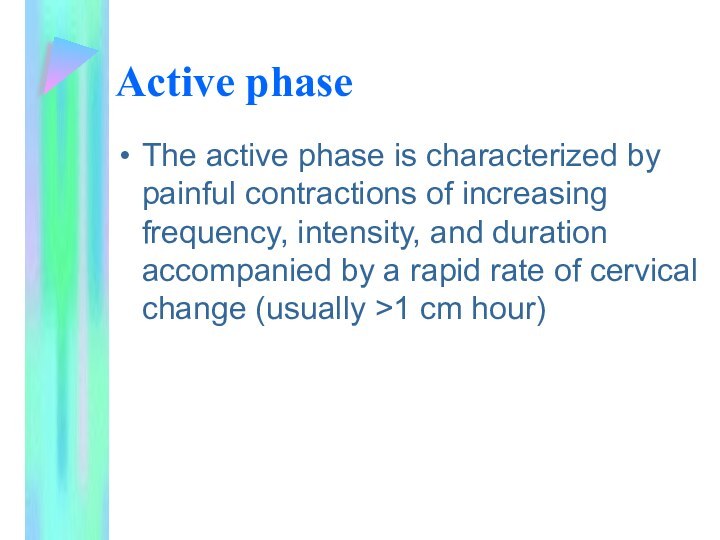
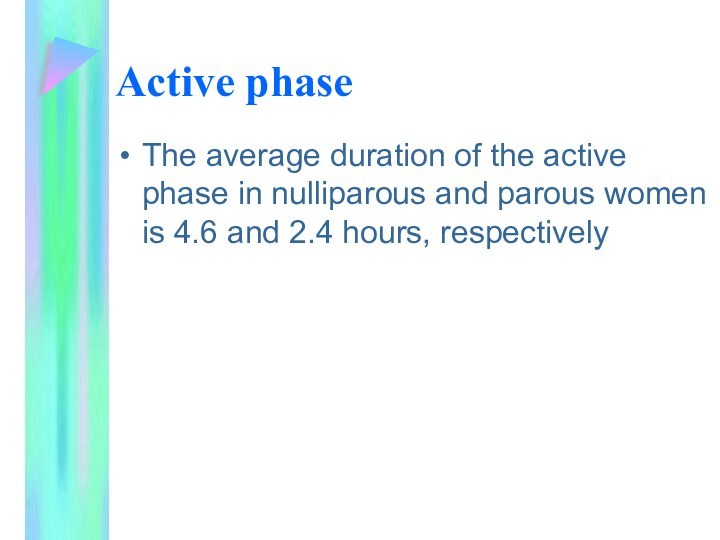




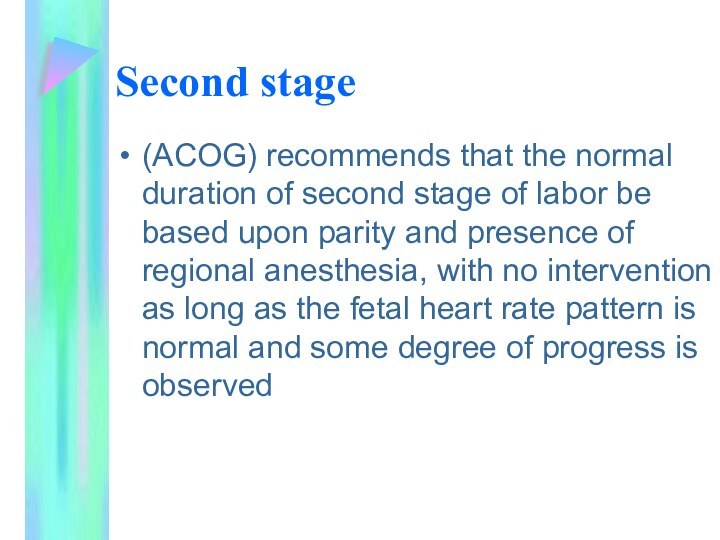







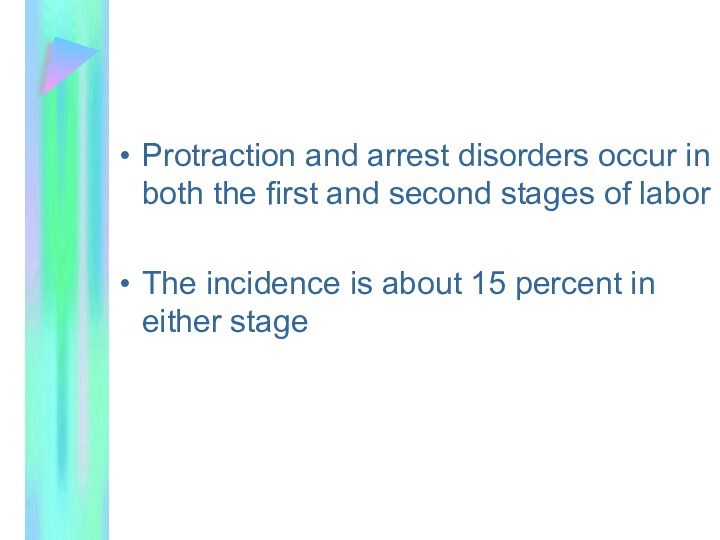







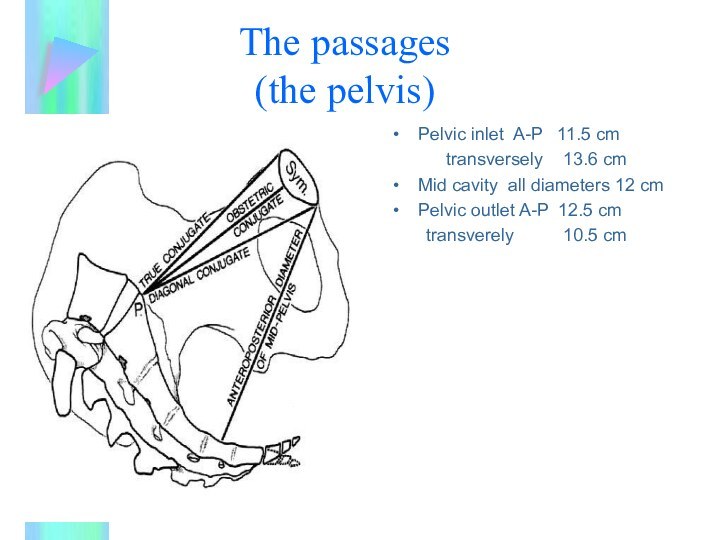

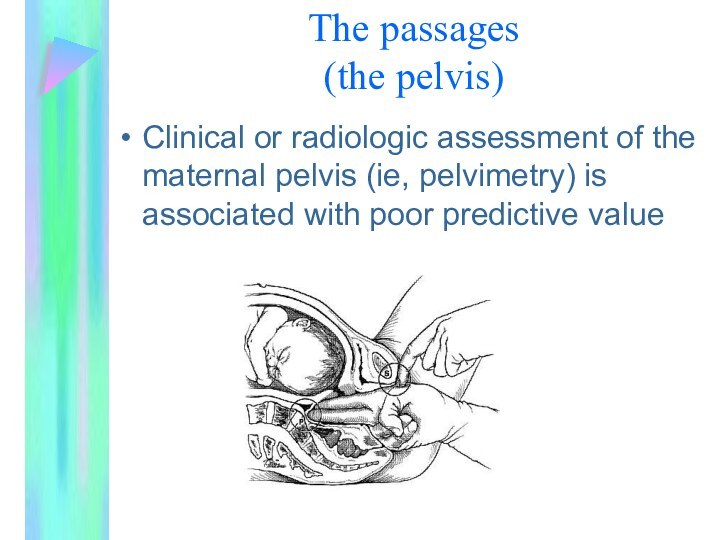






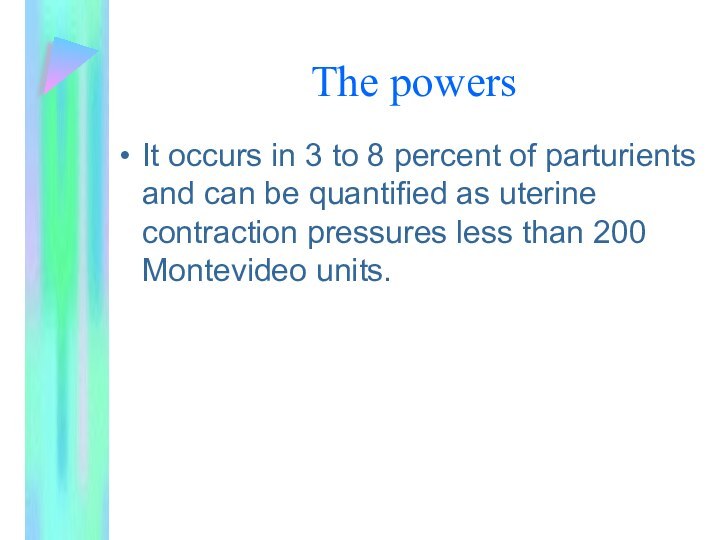




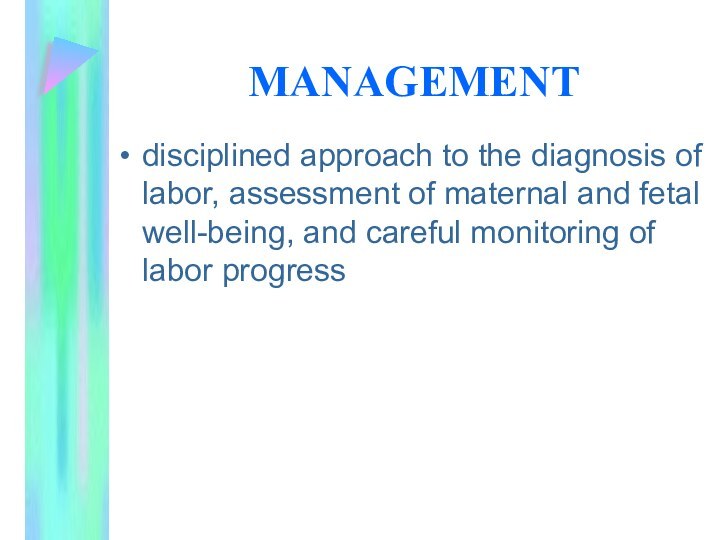

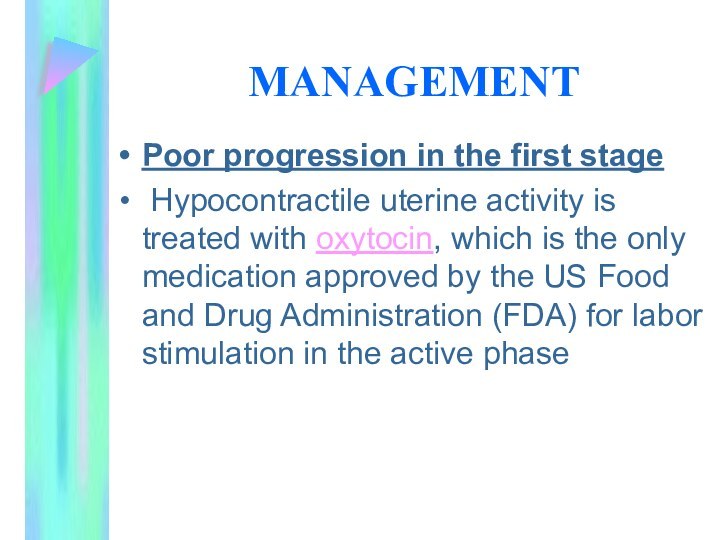



Слайд 3
Abnormal labor, dystocia, and failure to progress are
imprecise terms that have been used to describe a
difficult labor pattern that deviates from that observed in the majority of women who have spontaneous vaginal deliveries
Слайд 4
A better classification is to characterize labor abnormalities
as protraction disorders (ie, slower than normal progress) or
arrest disorders (ie, complete cessation of progress)
Слайд 5
Approximately 20 percent of labors involve either protraction
or arrest disorders
A labor abnormality is the most common
indication for primary cesarean birth
Слайд 6
NORMAL LABOR
Friedman, in his classic studies, divided
labor into three stages
First stage: time from the onset
of labor until complete cervical dilatation Second stage: time from complete cervical dilatation to expulsion of the fetus
Слайд 7
NORMAL LABOR
Third stage: time from expulsion of the
fetus to expulsion of the placenta
The first stage
is further subdivided into the latent and active phases, the active phase subdivided into three additional phases: acceleration phase, phase of maximum slope, and deceleration phase
Слайд 8
NORMAL LABOR
First stage = A + B +
C + D where
A=latent phase; B=acceleration phase; C=phase
of maximum slope; D=deceleration phase
Second stage = E
Слайд 9
Latent phase
The onset of the latent phase
of labor begins when the mother perceives regular contractions.
Слайд 10
Latent phase
This phase is typically characterized by mild
infrequent contractions and a gradual change in cervical dilation
(usually <1 cm per hour) and effacement
Слайд 11
Latent phase
The average duration of latent phase in
nulliparous and multiparous women is 6.4 and 4.8 hours,
respectively, and is not influenced by maternal age, birth weight, or obstetric abnormalities
Слайд 12
Latent phase
An abnormally long latent phase is defined
as 20 hours for the nullipara and 14 hours
for the multiparous womanIt reflect four standard deviations from the mean duration of latent phase in the women
Слайд 13
Active phase
The beginning of the active phase
typically occurs when the cervix has reached 3 to
4 centimeters dilation
Слайд 14
Active phase
The active phase is characterized by painful
contractions of increasing frequency, intensity, and duration accompanied by
a rapid rate of cervical change (usually >1 cm hour)
Слайд 15
Active phase
The average duration of the active phase
in nulliparous and parous women is 4.6 and 2.4
hours, respectively
Слайд 16
Active phase
An abnormally long active phase is defined
as 12 hours for the nullipara and 5 hours
for the multiparous woman
Слайд 17
Second stage
The mean duration of the second
stage of labor in nulliparous and multiparous women is
66 and 20 minutes, respectively
Слайд 18
Second stage
abnormally long second stage as three hours
for the nulliparous and one hour for the multiparous
woman
Слайд 19
Second stage
Neuraxial anesthesia, duration of the first stage,
parity, maternal size, birth weight, and station at complete
dilation all play a role in predicting duration of the second stage
Слайд 20
Second stage
(ACOG) recommends that the normal duration of
second stage of labor be based upon parity and
presence of regional anesthesia, with no intervention as long as the fetal heart rate pattern is normal and some degree of progress is observed
Слайд 21
Normal uterine activity
Uterine activity can be monitored
by palpation, external tocodynamometry, or internal uterine pressure catheters
Слайд 22
Normal uterine activity
External and intrauterine monitoring devices appear
to perform equally well, although the latter may work
better in obese women
Слайд 23
Normal uterine activity
Ninety-five percent of women in active
labor will have three to five contractions per 10
minutes
Слайд 24
Normal uterine activity
Montevideo units (ie, the peak strength
of contractions in mmHg measured by an internal monitor
multiplied by their frequency per 10 minutes) are most often employed
Слайд 25
Normal uterine activity
91 percent of women in spontaneous
active labor achieved contractile activity greater than 200 Montevideo
units and 40 percent reached 300 Montevideo unitsСлайд 27 Diagnostic criteria for abnormal patterns in active labor
Values represent approximately two standard deviations from the mean
Слайд 28
Protraction and arrest disorders occur in both the
first and second stages of labor
The incidence is about
15 percent in either stage
Слайд 29
In the first stage of labor
progressive dilatation
slower than the rate shown in the table is
suggestive of a protraction disorder
Слайд 30
An arrest disorder can be diagnosed when the
cervix ceases to dilate after reaching four or more
centimeters dilatation despite adequate uterine contractions (greater than or equal to 200 Montevideo units for two or more hours)
Слайд 31
second stage of labor
protracted labor is defined as
a second stage longer than two hours in nulliparas
(three hours when regional analgesia is used), and longer than one hour in multiparas (two hours when regional analgesia is used)
Слайд 32
An arrest of descent can be diagnosed after
one hour if there is no descent, despite good
maternal pushing efforts
Слайд 33
labor can be too fast as
well as too slow
The term precipitous labor refers
to a labor that lasts no more than 3 hours from onset of contractions to deliveryA precipitous second stage refers to a second stage that is less than 15 to 20 minutes in duration.
Слайд 34
ETIOLOGY
Abnormal labor can be the result of
one or more abnormalities of the cervix, uterus, maternal
pelvis, or fetus (ie, power, passenger, or pelvis)
Слайд 36
The passages
(the pelvis)
Pelvic inlet A-P 11.5 cm
transversely 13.6 cm
Mid
cavity all diameters 12 cmPelvic outlet A-P 12.5 cm
transverely 10.5 cm
Слайд 37
The passages
(the pelvis)
The clinician's ability to predict maternal
pelvis-fetal size discordance (cephalopelvic disproportion) leading to arrest of
labor requiring cesarean delivery has been disappointingСлайд 38 Clinical or radiologic assessment of the maternal pelvis
(ie, pelvimetry) is associated with poor predictive value
The
passages
(the pelvis)
Слайд 39
The passenger
Fetal weight, larger babies will have greater
difficulty in passing through the pelvis
Unfavorable position of the
presenting partFetal abnormalities such as hydrocephalus
Слайд 40
The passenger
The most common presentation is vertex, which
occurs in 96 percent of fetuses at term
Слайд 41
The passenger
The occiput is on the longer end
of the head lever. The chin is directly posterior.
Vaginal delivery is impossible unless the chin rotates interiorlyOccipitomental 12.5cm(face presentation mento posterior)





























